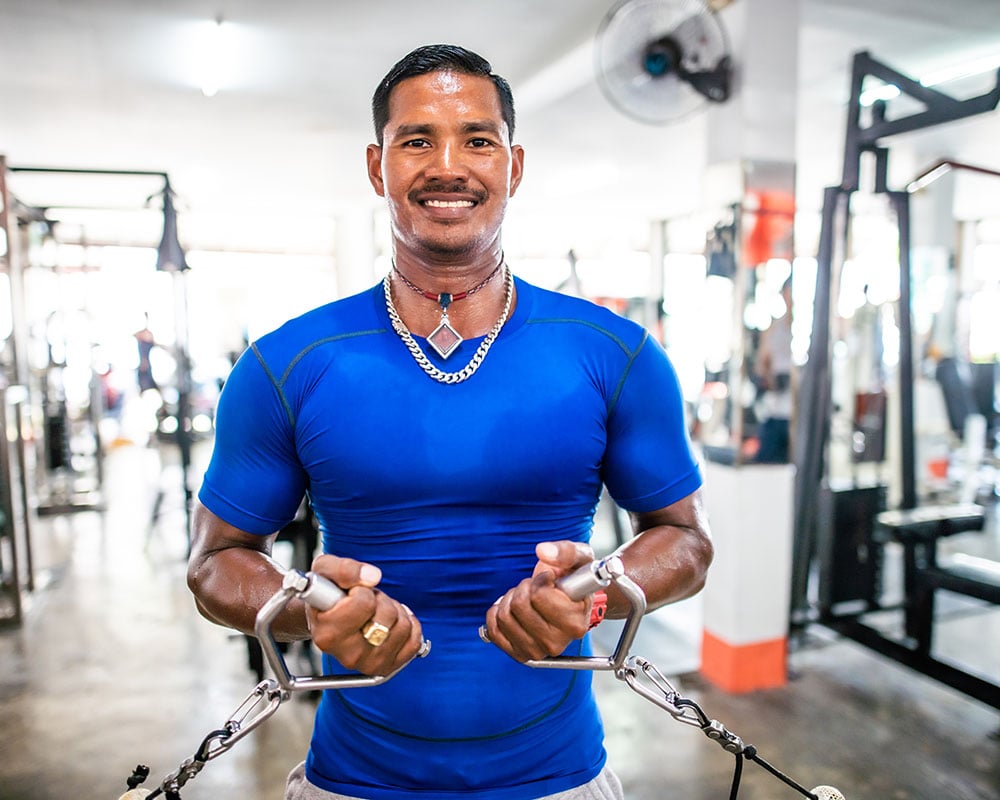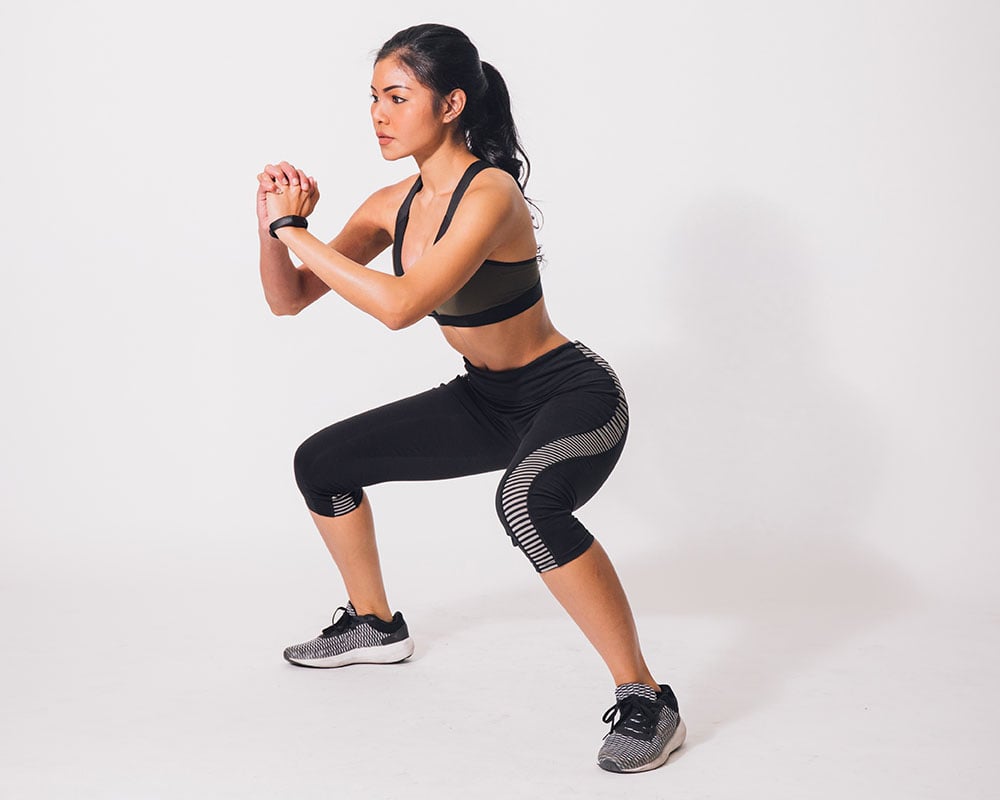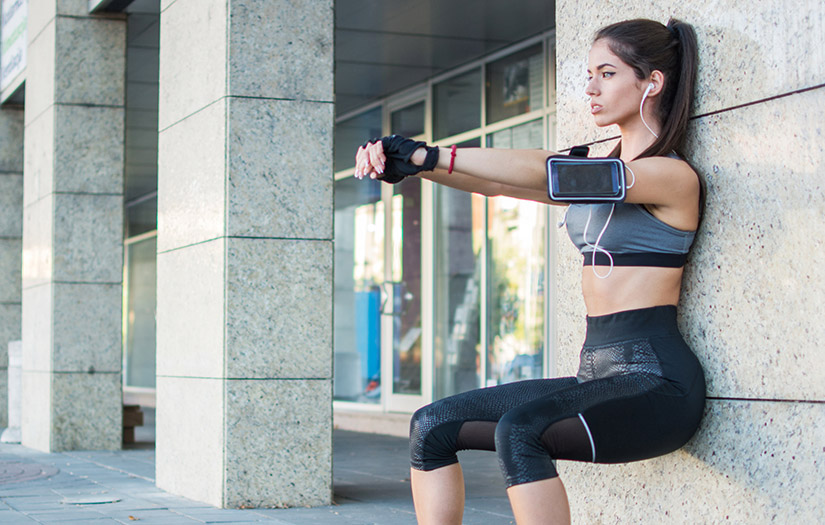As explained in the NASM-CPT 7 course, there are several types of muscle actions which are utilized to produce human movement; however, when most people think of exercise, they likely picture isotonic muscle actions. Isotonic muscle actions move a muscle visibly change length while developing tension (Sutton, 2021).
Isotonic muscle actions are further subdivided into eccentric and concentric actions. The eccentric muscle action occurs when a muscle develops tension while lengthening in response to a greater external force acting on it. The concentric muscle action is just the opposite in that the muscle develops tension while shortening in response to a lesser external force (Sutton, 2021).
This article aims to explore isometric muscle actions and how they are utilized during isometric exercise to produce fitness results.
Isometric Muscle Actions
An isometric muscle action occurs when muscle tension is created without a change in muscle length or visible movement of the joint (Sutton, 2021). In other words, the tension between two sets of muscles is either matched or collectively to match external forces placed on the body.
When the body is in motion, isometric muscle actions regularly occur to dynamically stabilize the peripheral joints and spine. Human movements utilize isotonic muscle actions as much as isometric muscle actions (Sutton, 2021). For instance, during a squat, the hip adductor and abductor's muscles contract isometrically, exerting equal force at the knee, preventing unnecessary movement, and maintaining stability in the frontal and transverse planes while other muscles move the hips, knee, and ankle in the sagittal plane.
Read more within: Muscles Used During Squats
While isotonic muscle actions move to activities, such as walking, isometric muscle actions contribute to the overall stability of the body by preventing movement where there should be none (Escamilla et al., 2016; Kisner & Colby, 2007; Sutton, 2021).
Isometric Exercise
Isometric exercises, also known as static exercises, emphasize isometric muscle actions across one or more joints, specifically where joint motion should be limited, such as along the spine for certain postures (Escamilla et al., 2016; Kisner & Colby, 2007).
Isometric exercises can be performed with or without weights and are generally accessible to everyone regardless of fitness ability. Unweighted isometric exercises are typically performed using the body’s weight or own force production for resistance.
For example, a plank requires the athlete to resist gravity using their body weight; or the athlete could press their hands together, matching their resistance. Weighted isometric exercises are very similar, except that resistance is provided by some external force, such as a resistance band, free-weight, or machine. For example, an athlete holding a specific posture and resisting movement while holding a resistance band or emphasizing a static hold at a specific point of a barbell squat are examples of weighted isometric exercises.
Whether within sport or everyday movement, physical activity that purely emphasizes isometric requirements is rare. However, isometric muscle actions are a key component of human movement and maintaining postural control, so it is important to develop isometric control, and isometric exercises may be the best way to prepare the body to resist both internal and external forces to maintain stable postures (Escamilla et al., 2016; Sutton, 2021).
The ability to maintain a stable posture is essential for everyone, whether an Olympic skier is maintaining their body position as they speed down the slopes or the average person maintaining their posture while carrying their groceries. Since physical activities are rarely performed without the body producing movement, isometric exercises are usually best utilized as a component of a larger integrated training program (Sutton, 2021).
Common Isometric Exercise Applications
As a component of a larger integrated training program, there are many ways to utilize isometric exercise. As a person moves through their environment, it is essential that they can decelerate, stop, and then change directions, and that is true whether someone is sprinting on a soccer field or getting a drink of water. While isometric exercises may help maintain and strengthen postures and improve joint stability, they are not the most effective means for developing force production (Sutton, 2021). Isometric exercises are most utilized for core training.
One of the goals of core training is to develop optimal levels of stability to minimize unwanted movement of the spine, maintain intervertebral and lumbopelvic stability, and promote movement efficiency for the peripheral joints (Escamilla et al., 2016; Sutton, 2021). Isometric core exercises primarily target the local core musculature to improve neuromuscular efficiency and improve intervertebral stability.
The isometric portion of any movement occurs when moving around a joint is stopped, which often occurs before the start of the next movement. For example, as a person performs a squat, there is a moment at the bottom of the squat when movement ceases before returning to a standing position. At that moment, the person challenges their ability to control their posture and avoid compensated movement isometrically. Regardless of athletic ability, everyone will eventually discover the threshold at which they can no longer successfully maintain stability for any given posture (Kolber et al., 2017).
Those thresholds could have several causes ranging from impaired motion, poor neuromuscular control, fatigue, and strength (Sutton, 2021). Isometric exercises are ideal for increasing an athlete’s ability to minimize movements and stabilize their posture during those critical moments. One way to do this would be to place the body in a posture and under a level of stress close to the conditions in which compensations would occur and then hold the posture. If the variables are consistent and progressive in terms of external forces and time under tension, the person’s ability to maintain that posture under similar conditions should improve.
Physical rehabilitation is another common setting in which isometric exercises benefit many neuromuscular and musculoskeletal conditions, such as acute and chronic pain (Kendall et al., 2005; Kisner & Colby, 2007). Isometric exercises help to improve stability and strength for individuals unable to move.
While traditional exercise and resistance training may be more beneficial for building strength and enhancing physical performance, some individuals may be too unstable, or experience pain during movement and so are unable to participate in traditional exercise activities (Sutton, 2021; Kisner & Colby, 2007). Consistent application within the physical rehabilitation setting may provide a pathway towards more traditional means of exercise requiring greater stability and a wider range of movements (Kendall et al., 2005).
3 Examples of Isometric Exercise

Plank
The prone isometric ab exercise, aka the plank, is probably the most well-known example of an isometric exercise. The plank requires isometric muscle contractions throughout the lumbopelvic-hip complex, otherwise known as the core. During the plank, the core muscles activate to stabilize the lumbar spine and pelvis against gravity with no visible motion of the body. To perform a plank, position yourself as if you were going to perform a push-up and fully extend your harms with your hands placed directly beneath the shoulders.
The idea is to hold the position and minimize movement throughout the body, especially the spine, aligned with the five kinetic chain checkpoints. Do this by drawing in your navel toward the spine and engaging your glutes to maintain a neutral pelvis position and lumbar spine. The shoulders should be protracted and depressed, with the head retracted and the chin slightly tucked.
The body should form a straight line from the heels to the head. The plank may either be held for a targeted period without compensation or done repetitiously, with emphasis placed on the hold for 1-2 seconds for beginners. The plank can be regressed by resting the knees on the floor and maintaining a straight line from knees to head, or the hands may be placed on an elevated surface such as a bench.
The plank may also be progressed by alternately lifting one of the feet off the ground and pointing the toe, emphasizing extension of the hip, knee, and ankle for the duration of the plank. By raising one foot off the ground, the body must resist movement in the transverse plane, providing an anti-rotational element.

Standing Cable Anti-Rotation
The standing cable resisted anti-rotation is another excellent example of a transverse plane isometric exercise. Perform the standing cable anti-rotation by standing with your feet hip-width apart and toes pointed straight ahead. Draw in your navel to brace the lumbar spine, contract your glutes and retract your head with the chin slightly tucked.
With both arms fully extended, hold the cable handle with both hands centered in front of the chest. The idea is to hold the posture for a targeted period without compensation, much like the plank, while resisting the external rotational force. The exercise could be regressed by repositioning the resistance to the sagittal plane and challenge the posture to resist either spinal flexion or extension.
The exercise could also be progressed to a standing iso-rotation, which is very similar to the standing anti-rotation except the iso-rotation requires the maintenance of posture while slowly rotating the leg closest to the source of resistance, arms, and torso together as a unit, away from the source of resistance, with a 1-2 second pause at the end of the motion before returning to the starting position. Again, the leg that you rotate towards should remain still, and aside from the rotation at the hip, there should be very little movement throughout the rest of the body.

Squat Hold
The squat hold is another popular isometric exercise and is especially effective for developing greater postural stability of the lower limbs near the end range of a person’s squat. The squat hold may be performed using your choice of resistance bands, free weights, or using only bodyweight, depending on your current ability and preference.
To perform the squat hold, begin with your feet placed hip-width apart, your toes pointed straight ahead. The position of your hands and arms may vary depending on the type of resistance, but regardless, the shoulders should be slightly retracted. As you descend into the squat, keep your heels on the ground, allowing the hips to sit back while maintaining alignment between your knees and toes. The line of the torso should remain parallel with the line of your shines.
Pause the squat once the thighs become parallel to the floor or just before compensation begins. Then hold the posture for a targeted amount of time without compensation, or repetitiously holding each pause for 1-2 seconds before returning to the standing position.
The squat hold may be regressed by utilizing the hold at the bottom of a ball wall squat, which utilizes a fitness ball positioned between your back and the wall. The ball wall squat helps individuals learn proper movement and gain the required stability to perform a traditional squat. The squat hold may also be progressed by shifting the feet into a staggered stance while performing the squat. Think of the staggered-stance squat as a single-leg squat, except with the support of the second leg to carry a portion of the load and add stability.
Programming Isometric Exercise
Isometric exercises are most effective when integrated into a more extensive program. The Optimum Performance Training (OPT) Model utilizes isometric exercises and emphasizes isometric muscle actions throughout the stabilization endurance level of training (Sutton, 2021). Isometric exercises and holds are utilized throughout stabilization training, especially during the program's activation, skill development, and resistance training portions.
The evidence-based OPT model suggested 1-3 overall sets with rep ranges between 12-20. For core activation, selecting 1-4 exercises, such as the plank, would be appropriate (Sutton, 2021). The skill development portion of the program provides the opportunity to include 1-3 plyometric exercises.
Plyometric exercises during stabilization training emphasize isometric muscle actions by holding the landing position for 3-5 seconds between reps for a total of 5-8 repetitions, unlike the rest of the program (Sutton, 2021). Additionally, 1-3 exercises per body part or movement pattern are appropriate during resistance training (Sutton, 2021).
The 4/2/1 tempo utilized during resistance training emphasizes isometric muscle actions between eccentric (4-second) and concentric (1-second) muscle action, which translates to 1-2-second holds at each end of the exercise.
Overall, a Phase 1 Stabilization Training level workout utilizes isometric exercises and emphasizes isometric muscle actions through brief postural holds during each exercise, and may be performed 3-5 days per week based on your tolerance and ability to recover (Sutton, 2021).
References
Escamilla, R. F., Lewis, C., Pecson, A., Imamura, R., & Andrews, J. R. (2016). Muscle activation among supine, prone, and side position exercises with and without a Swiss ball. Sports Health, 8(4), 372–379. https://doi.org/10.1177/1941738116653931
Kendall, F. P., McCreary, E. K., Provance, P. G., Rodgers, M. M., & Romani, W. A. (2005). Muscles: Testing and function with posture and pain (5th ed.). Baltimore, MD: Lippincott Williams & Wilkins.
Kisner, C., & Colby, L. A. (2007). Therapeutic exercise: Foundations and techniques (5th ed.). Philadelphia, PA: F. A. Davis Company.
Kolber, M. J., Stull, K. R., Cheatham, S. W., & Hanney, W. J. (2017). The influence of muscle impairments on squat performance. Strength and Conditioning Journal, 39(3), 66–73.
Sutton, B. (Ed.). (2021). NASM Essentials of Personal Fitness Training. Jones & Bartlett Learning.

















